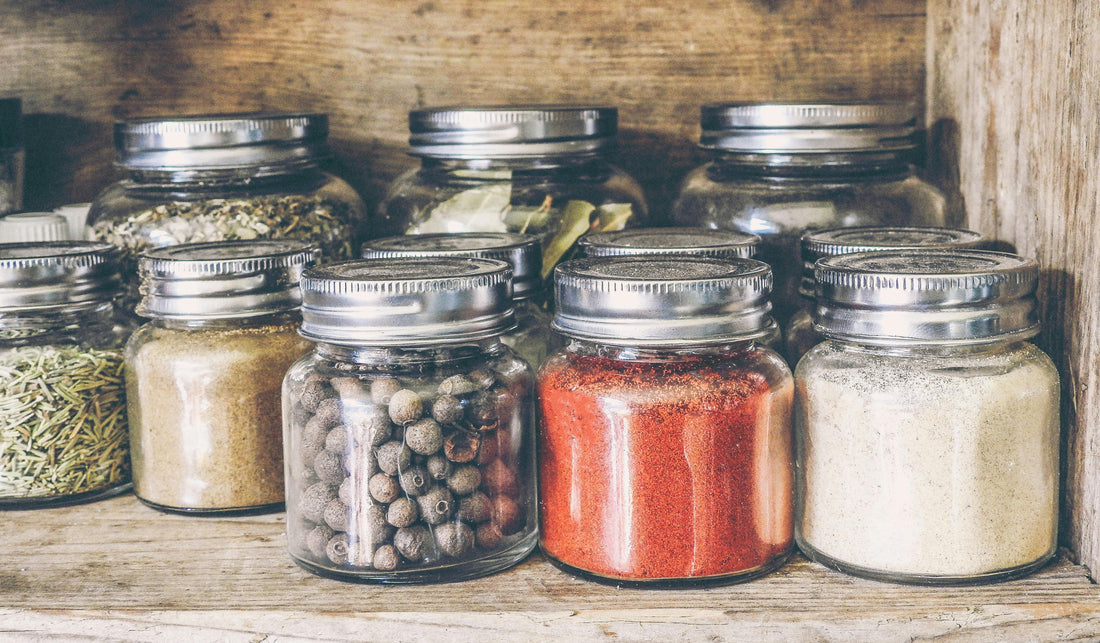Compact and appealing in shape, square spice jars offer an economic use of space. Their often wide mouths allow easy stacking and side-by-side arrangement in large numbers. They are easy to grip and fill up. And with flat surfaces, you can label them with ease. Glass square spice jars may appear fragile, but are versatile and reusable. With their many protective features, they can store several substances. Beyond spices and condiments, they can keep both dry and moist foods. And for many months.
Square spice jars used as tea coffee sugar glass jars are quite common. But a word of caution. To enjoy using glass square spice jars requires obeying certain food-specific rules. We will discuss how best to use them to store dry goods. Even more so, tea coffee sugar glass jars need extra attention.
Tea, Coffee & Sugar - Why Use Square Spice Jars?

Tea, coffee, and sugar are heavily-consumed staples worldwide. But these three foods absorb the smells and tastes of nearby substances. The effect on your taste buds can be displeasing. Which means herbs, spices, foods, and substances with strong smells should stay far away.
Again, environmental conditions have a quick impact on tea and coffee. These conditions can impact on their quality in serious ways. Exposure to light, oxygen, heat, and humidity/moisture are key factors. And different types of tea or coffee also have different shelf lives. Which means poorly-stored tea or coffee can lose its flavour and aroma fast. As such, they both need extra protection.
One might also argue that sugar does not go bad. But it can absorb water and become clumpy. Which makes it difficult to use in many recipes.
Hence, airtight square glass jars are suitable for keeping tea, coffee, and sugar. Jars with double lids are even better. Tea coffee sugar jars of varied materials are in existence. They could be tin-coated steel, ceramic, glass, or plastic canisters. But glass jars have special merits.
If handled well, glass exhibits these special qualities:
- Glass is unique for its clarity. It is easy to observe any activity inside it.
- You can rid glass of all previous smells, tastes, and remnants through sterilization. It may be difficult to do so with plastic and metal.
- If they remain intact, you can reuse glass jars and bottles almost without end.
- Glass does not react with any substance. It does not leach any toxic substance into its contents. Food-grade plastic and metal canisters are safe for the moment. But you cannot predict when they become reactive, or start leaching.
- Glass can protect its occupants from moisture, gases, insects, and microbes. Coloured glass can provide additional shield from the sun and UV rays.
- Toughened glass is resistant to very high and low temperatures and pressures.
Best Tips for Protecting Dry Foods in Glass Jars
How can you safeguard your priced tea or coffee from losing quality? Green teas, and ground coffee are more sensitive to oxygen, heat, and light. Sugar also needs protection from moisture.
In general, you must protect dry foods from extreme or fluctuating temperatures. Also ensure the location is moisture-free. To stop spoilage, store dry foods within 10 to 15 degrees Celsius. Long-term storage of dry foods in glass containers works well. This includes square spice jars. Follow the tips below to get satisfying results:
- Buy and store tea and coffee in small quantities. And drink them up within a few weeks.
- Keeping your filled glass tea coffee sugar jars in protected places is necessary. Hide tea, coffee, and other dry foods away from light and moisture. Dark cabinets, pantry, cellar, or cartons are helpful. Or line the inside walls of the jars with foil. You can install a dehumidifier to further reduce atmospheric moisture. For all three foods, do not use the refrigerator or freezer.
- You can reuse glass jars to store dry foods. But you must sanitize them. Scrub them inside-out with hot water and mild soap or dishwashing detergent. The lids also need thorough scrubbing. Go a step further - immersion in boiling water is a simple sterilization method. Or use a dishwasher, heated oven, vinegar or alcohol spray.
- Most living organisms need oxygen. So it is wise to snuff out the gas from your glass jars. Inserting oxygen absorbers inside them can remove insects and many microbes. Each gallon of food needs about 300cc of oxygen absorber. While 50cc will serve about a quart jar. To absorb moisture, you can use silica gel along with the oxygen absorber. But foods with enough water or oil to attract microbes cannot use them. For instance, brown sugar, nuts, and brown rice are easy prey.
- You can freeze-thaw your dry foods to kill off insects and their eggs. Do this before putting them into the glass jars. Place the dry food inside a water-proof bag. Then transfer it into a freezer for 3 days. Afterwards, remove the bag and leave it at room temperature for a day. This will hasten the eggs to hatch. To make it more effective, repeat the procedure again - at least once.
- Another effective way to remove oxygen from the jars is through vacuum sealing. It works along with jar sealers. However, vacuum sealing of dry foods for extensive periods makes more sense. Such foods remain intact for many months. It works best on large canning jars with wide mouths.
Final Words
There are benefits in storing dry foods in glass square spice jars. Like grains, sugar, tea, or coffee. You can arrange them in a compact way to save space. They are also easy to handle.
But tea coffee sugar jars need extra care. This is due to the increased sensitivity of these foods to environmental factors. Above all, keeping dry foods in glass jars is excellent. But the environment must have low humidity and controlled temperatures.

